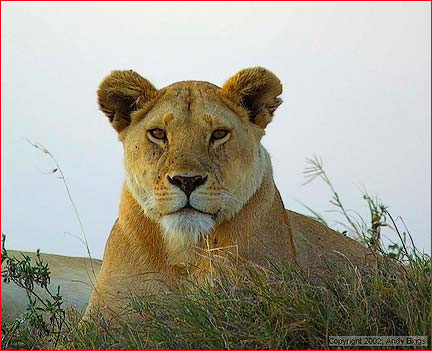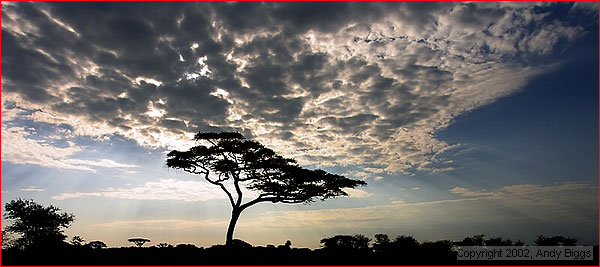This Workshop is Limited to Just 9 Participants

About The Workshop
Looking for a photographic destination this summer? Well this is it! The workshop will be a 12 day trip‚ from June 30th to July 11, 2003. The workshop will be conducted in the east African country ofTanzania, home to theSerengeti National Park, theNgorongoro CraterandMount Kilimanjaro. It will combine an exciting photography workshop in one of the world’s most outstanding wildlife, landscape and cultural locations together with a luxury vacation‚ in fascinating Tanzania. This workshop is open to just 9 participants.
__________________________________________________________
Tanzania
Tanzania, south of Kenya on the African continent’s Indian Ocean coastline, lays claim to the title‚ Home of the Safari, since the word itself is taken from the Swahili word that means‚ journey. While Tanzania’s Kenyan neighbors may dispute that claim, there is no doubt that Tanzania offers one of the best environments in the world for an enriching wildlife experience. The country’s game viewing opportunities are considered by many to be the best in Africa. Its game parks are populated with many of the world’s most exotic creatures, including all of the‚ Big Five. Its lakes are huge and bountiful with fish. Its cities are relaxed and friendly. Yet, to a greater degree than is true of many of its neighbors, this sprawling county, the largest in East Africa, remains untouched by the vacationing hordes.

__________________________________________________________
It’s About Photography‚ Lots of it!
This workshop will be very informal and fun. Andy Biggs will be shooting alongside you at all times. We will have discussion and assistance on specialized topics such as, for example, long lens technique, projection flash usage, action shooting, wildlife observation, field craft and east African animal behavior. Advanced techniques will be constantly discussed, demonstrated and put into practice.
This workshop is about shooting‚ lots of shooting. There will be no classroom sessions, no lectures, no slide shows, and most importantly‚ no unnecessary egos. We will all work closely together, sharing our knowledge and experience.
Because of the unique location of this workshop, and the luxury accommodations, this workshop adventure is open to spouses as well as photographers. Even non-photographers will find the locales visited and the wildlife viewing opportunities to be thrilling. The cost for non-photographers is the same as for active participants and the 9 places available include both photographers and non-photographers.

__________________________________________________________
About Equipment & Extras
Workshop participants will be provided with comprehensive equipment suggestions. You may shoot film or digital, and all of our accommodations along the way will have electrical outlets. A long lens in the range of 300-500mm is highly recommended. All participants will be provided with a complimentary bean bag and projection flash equipment for use while on safari. These devices are a must for effective wildlife photography with longer lenses.
The use of anImage StabilizedorVibration Reductionlens is highly recommended if your system has these available.
Tripods are not required, as almost all photography will be performed from a safari vehicle. However, a lightweight monopod can be used for support while in our safari vehicles. A light weight tripod may be brought along for occasional landscape and macro work.
__________________________________________________________
The Schedule
This adventure wildlife workshop requires 12 days from your normal schedule. Here are the dates, an itinerary, and some details on what we will be able to see and photograph.
Monday, June 30th, 2003 ‚ Depart USA (applicable for those opting for additional airfare from New York or Boston).
Tuesday, July 1st, 2003 ‚ Amsterdam to Arusha, Tanzania.
Upon arrival, you are met by our guide and transferred to theMountain Village Lodge. The Mountain Village Lodge is a working coffee plantation, six miles from Arusha in a stunning setting overlooking Lake Duluti with magnificent views of Mt. Meru and Mt. Kilimanjaro. Room accommodations are double rondavels (round bungalows).
Wednesday, July 2nd, 2003 ‚ Arusha to Tarangire National Park.
After breakfast at the hotel, we depart Arusha for scenic Tarangire National Park, Tanzania’s fourth largest National Park. Here you’ll find a geologic landscape as diverse as the wildlife, with nine distinct vegetation zones ranging from grassland to woodland, from deep gully vegetation to scattered rocky hilltops. See the distinctive bulbous baobab trees and the dramatic vistas of the Tarangire River valley. The river attracts an abundance of wildlife, from elephant, lion, cheetah, and buffalo to a variety of colorful birds. Overnight at theTarangire Safari Lodge.
Thursday, July 3rd, 2003 ‚ Tarangire National Park.
Wildlife Viewing: Tarangire National Park. Overnight at theTarangire Safari Lodge.
Friday, July 4th, 2003 ‚ Tarangire National Park to Ngorongoro Crater.
After breakfast, we head toward Ngorongoro Crater, entering the lush green foothills where temperatures are cooler. We stop for our first look at the collapsed caldera of Tanzania’s "Garden of Eden," gazing down into the verdant crater below. We arrive at the lodge in time for lunch.
For the afternoon, and the entire next day, we descend 2,000 feet into this magnificent crater to view wildlife. Here a nearly perfect balance of predator and prey exists within the 102 square miles of the crater floor. Experience an unforgettable spectacle of African wildlife: a teeming world of elephants, rhinoceros, lions, hyenas, zebra, wildebeest, to name a few, living in harmony in this self contained environment. At the end
of each day we ascend the crater wall to our lodge perched on the rim. Overnight atNgorongoro Sopa Lodge.Saturday, July 5th, 2003 ‚ Ngorongoro Crater.
Full Day of wildlife viewing on the Crater Floor.
Sunday, July 6th, 2003 ‚ Ngorongoro Crater.
Leaving the Ngorongoro Conservation Area, we stop at the famed Olduvai Gorge, where some of the earliest remains of our species were unearthed by the dedicated Leakey family. Here in these desolate gullies the jawbone of Zinjanthropus Man was discovered. The Gorge Museum explains the Leakeys’ methods and their remarkable finds. We then begin the journey into the great Serengeti traveling deep into the wilds of Africa. The sight of giraffe, lion, ostrich, zebra and warthog will dazzle you. See herds of animals swiftly running across vast open spaces, and predators hunting prey. The multitude and diversity of species here is unrivaled. We spend three nights in the impressiveSerengeti Sopa Lodgein the Central Serengeti.
The Serengeti National Park is one of the world’s last great wildlife refuges. It is a land of vast grassland plains, acacia-studded savannas, wooded hills and mountains. Contiguous with the Masai Mara park on the Kenyan side of the border, the Serengeti is home to a breathtaking array of wildlife. At any point in time, the park’s vast grassland plains and savannas will be strewn with pockets of grazing zebras, giraffes, gazelles, wildebeest and topi. The acacia forests will abound with bird life and monkeys. Elephants and buffaloes will be wallowing in the swamps, and the rivers will be brimming with hippos and crocodiles, watched over by the storks that stand on the sandy riverbanks.
The extraordinary concentration of animals in the park reaches its peak during the annual wildebeest migration, when the promise of rain and new grass in the north, in the Masai Mara, leads as many as 1.5 million wildebeest and their zebra fellow travelers to pick up roots and set off on a 600-mile (1000-kilometer) migratory circuit. Millions of animals coalesce into a single massive herd in the months of December through February, and surge northward in a pulsing column of life that stretches from horizon to horizon. The lions and other predators of the park are on high alert during the migratory season.
The Serengeti’s name is derived from the apt Masai word Siringet, which means‚ endless plains. The Seronera Valley in the Serengeti is famous for its abundant lions and leopards.
Monday, July 7th, 2003 ‚ Serengeti National Park.
Full Day of wildlife viewing in the central region of Serengeti National Park.
Tuesday, July 8th, 2003 ‚ Serengeti National Park.
Full day wildlife viewing: Serengeti National Park.
Wednesday, July 9th, 2003 ‚ Serengeti National Park.
Early morning departure for and wildlife viewing en route to the Northern Corridor.Migration Campis a small, luxury tented camp nestled in the Ndassiata Hills in the northern Serengeti, overlooking the Grumeti River. Resident game include lion, leopard, elephant, buffalo, hippo, and baboon. Electricity is provided by a generator for recharging of any electrical devices.
Thursday, July 10th, 2003 ‚ Serengeti National Park.
Morning wildlife viewing en route to Klein’s airstrip for the flight (33lbs baggage limit) to Arusha. After lunch there will be time to relax, shop or sit by the pool. Mount Meru Hotel – Day room for the afternoon. Early evening transfer to Kilimanjaro Airport for your flight to Amsterdam.
Friday, July 11th, 2003 ‚ Arrive Amsterdam and connect to your final destination.
__________________________________________________________
The Cost
The cost of this all-inclusive trip is U.S. $5,190 per person (but not inclusive of airfare to Arusha, Tanzania). The same rate applies for each participant regardless of whether they are doing photography and participating in the workshop, or not. This fee includes all in-country ground and air transportation as well as hotel accommodation (double occupancy) and all meals. Minimum number of participants is 4.
Accommodations are two person to a room. If you will be traveling alone and would like a private room there will be a supplementary charge.
For an estimated fee of $1800, you can choose to have the flight from New York booked for you. We encourage this service if you are departing from North America, as we will all be able to arrive in Tanzania on the same flight at the same time. It is our experience that this service eliminates many scheduling headaches, and the cost is at or slightly below the average market rate for such a flight.
__________________________________________________________
What’s Included?
- All Game Park fees
- All accommodations, based on double occupancy
- All meals inclusive of restaurant staff tips
- Services of guides and drivers
- Land transportation in safari Land Rovers with a maximum of three passengers per vehicle. For the photographer, this is an essential requirement, as we need room to move around and photograph, especially for those with large lenses.
- Airport transfers to and from hotels
- Internal airfare from Serengeti to Arusha
- Bottled water at all times
- $30 Tanzanian Airport departure tax, if KLM / NW ticket purchased through us. __________________________________________________________
What is Not Included?
- Additional tips for staff such as guides and camp staff
- Fees for passport, visas, immunizations and insurance
- Alcoholic beverages while on safari
- Laundry, phone and other items of a personal nature
- Cost of hospitalization and evacuation if necessary
__________________________________________________________
What Do I Do Next?
If this workshop has your name on it; if you’re excited by the thought of becoming a member of this trip, then now is the time to register.
Remember, there are only 9 positions available for this workshop. When they’re spoken for, that’s it. If you have any questions before registering,click hereto send any e-mail inquiries.
__________________________________________________________
Additional Dates
Similar workshos are also being offered on the following dates. Please call or write for details.
January 16 – January 26, 2004
June 7 – June 17, 2004
June 19 – July 1, 2004
July 18 – July 28, 2004__________________________________________________________
You May Also Enjoy...
Dig-vid
A Digital Imaging Tutorial From Issue #4 Click on the image below to play a briefQuicktimevideo clip from Issue #4 of theVideo Journal. Remember,
